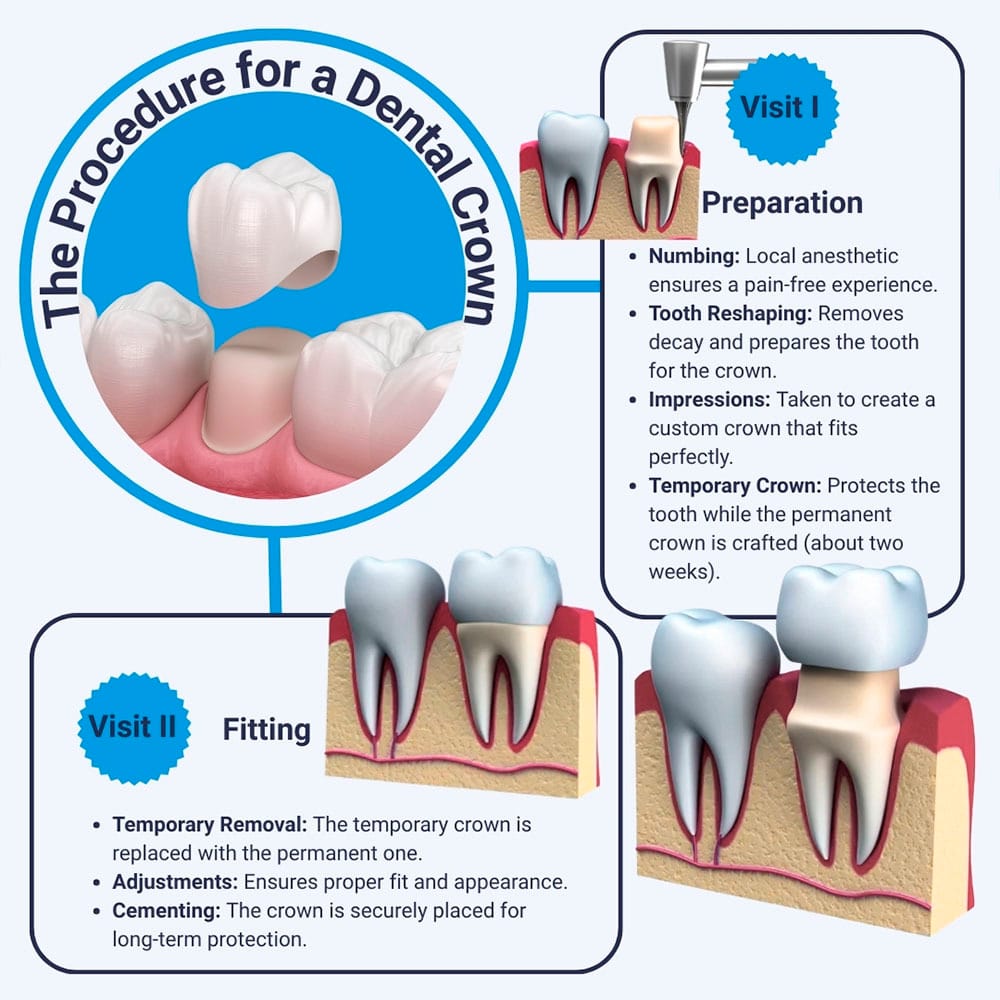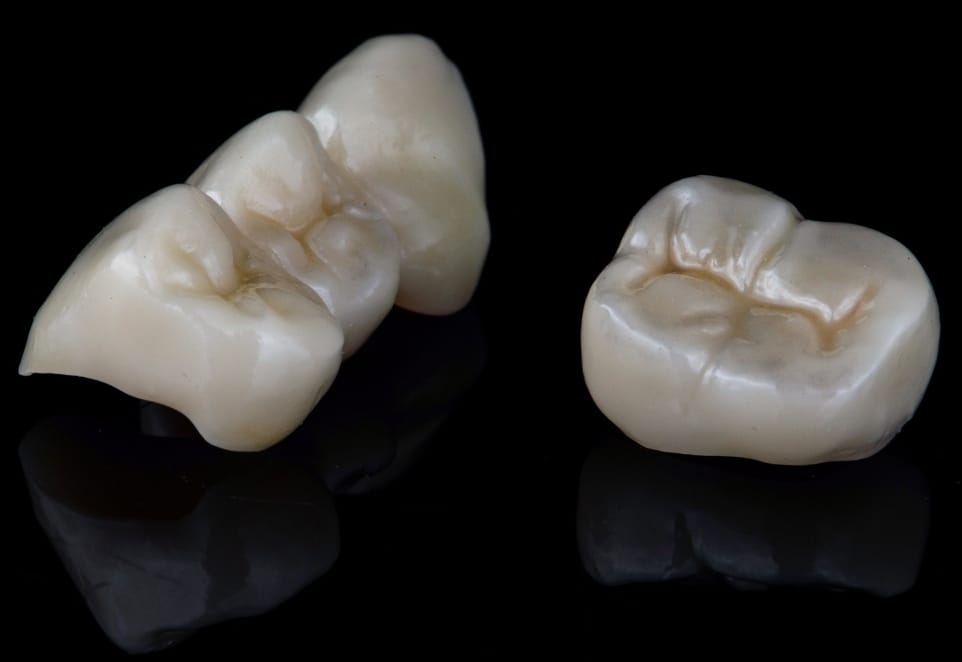What Is a Dental Crown?
A dental crown covers a tooth entirely and is sometimes called a cap. It fits right over the tooth and down to the gum line, so none of the original tooth is visible.
Your dentist may suggest a dental crown in the following situations:
- Covering a tooth with severe decay or infection.
- Restoring a tooth after root canal therapy.
- Restoring a tooth that has suffered significant trauma, losing some of its original structure.
- Covering a tooth that is discolored, worn, or not quite the right shape to improve its appearance cosmetically.
Read more: Metal Crowns vs. Porcelain Dental Crowns

What Will Happen If I Need a Dental Crown?
If you need a dental crown, your dentist must examine and X-ray the tooth first. They must ensure the tooth is strong and healthy enough to be restored with a dental crown.
If you have signs of infection or decay, your dentist will want to see how far this extends into the tooth. You may need another treatment before your crown can be made and fitted to get rid of a severe infection, for example, root canal therapy.
Once your dentist has determined a dental crown is appropriate, they will want to discuss which type of crown you prefer. Several types are available depending on the materials you choose.
Options can include:
- Metal crowns.
- Porcelain fused to metal crowns.
- All ceramic crowns.
Metal Crowns
A metal crown can be made from various types of metals. If the crown is to cover a primary tooth that will soon fall out to make room for an adult tooth, your dentist may recommend using a preformed stainless steel crown. The crown can be adapted to fit over the damaged tooth reasonably well and is a cost-effective solution.
Otherwise, when restoring a permanent tooth, your dentist will recommend some type of precious metal alloy that can be gold or silver-colored. The precious metal is polished, so it looks shiny and attractive. Precious metal is a good option because it is long-lasting and kind to the opposing teeth.
However, a precious metal crown will be highly visible in the mouth.
While some people will actively choose to have a gold crown in their smile line, others will prefer to have this type of crown fitted over a back tooth that is less visible.
Read more: The Pros and Cons of a Dental Bridge
Porcelain Fused to Metal Crowns
A porcelain fused to metal crown or PFM is a traditional type of crown that has been widely used for decades. A thin metal substructure is made from some type of metal alloy and covered with porcelain. The result is a reasonably lifelike crown that is durable and hard-wearing.
However, a PFM may lack the translucency you associate with natural teeth because of that metal substructure that must be covered with an opaque porcelain to block it out. Also, if gum recession occurs as the crown ages, it can gradually expose the edge of the crown where the porcelain is thinner. Consequently, you may notice a gray line around the margin closest to your gum.
All Ceramic Crowns
These crowns are the most modern and are entirely metal-free. They can be made from a pressable ceramic material or zirconia, an extremely strong material.
Pressable ceramic crowns are the most aesthetically pleasing and highly suitable for restoring front teeth.
Zirconia crowns are stronger and can be used anywhere in the mouth. They are even suitable for people who clench and grind their teeth, which can often damage dental restorations like crowns. Modern zirconia crowns are far more translucent than earlier versions and can create excellent aesthetic results.
Read more: What are the Stages of Periodontal Disease?
The Procedure for a Dental Crown
The procedure for a dental crown will normally require at least two more appointments after your initial visit to assess the tooth.
Visit One: Preparing Your Tooth
The steps for tooth preparation are outlined below.
- Tooth preparation is carried out after numbing your tooth first with a local anesthetic. Treatment should be entirely pain-free.
- Once your tooth is numb, the dentist will carefully reshape it, removing some tooth structure, infection, and decay. Even if you require a tooth for aesthetic purposes, it may be necessary to remove some tooth structure to ensure there is plenty of room for the crown to fit comfortably.
- Once your tooth is prepared, your dentist takes a dental impression, which will be used to custom-make your new crown. If you intend to have a porcelain crown, they will also take the shade of your tooth so the dental technician can match your new crown exactly.
- A temporary crown is fitted over your tooth to protect it while your new crown is made. It will generally take two weeks to make your crown.
Visit Two: Fitting Your New Crown
When the crown is ready you return to your dental office to have it fitted.
- Usually, an anesthetic isn’t needed for this appointment. Your dentist will remove the temporary crown and try in the new crown.
- They will check your new crown to ensure it fits precisely, and you will get a chance to preview its appearance to ensure you are happy with its appearance.
- Your new crown is permanently cemented onto your tooth, and any final adjustments are made.
Same-Day Crowns
Some dental offices now offer same-day crowns, where your new restoration can be custom-made and fitted during the same appointment.
The process is very similar as your tooth and still needs to be prepared. The next steps are outlined below.
- Once your tooth is prepared, your dentist will take a digital dental impression. They use special software to custom design your crown while you remain in the dental chair.
- When the design is ready, it is sent to an on-site milling machine. The machine mills your new crown to your dentist’s design from a solid porcelain block. The porcelain is pre-shaded, so it already closely matches your natural tooth.
- After the tooth is milled, it is carefully checked and hand-finished. During hand finishing, the crown is characterized and can be stained and glazed so it blends in with your natural teeth beautifully.
- The new crown is now ready to fit and can be cemented onto the tooth.
Same-day crowns are precision-made, high-quality restorations that save you time and the inconvenience of a second visit. However, they may not be right in every situation. For example, suppose you need multiple crowns or other restorations. In that case, your dentist may recommend making them in a dental lab where a technician can closely match all the materials and shades needed.
Read more: Preparing for Gum Graft Surgery: A Step-by-Step Guide
Crowns over Dental Implants
While most dental crowns are fitted over natural teeth, a dentist can also use a dental crown to restore a dental implant. After the implant is inserted into your jawbone and has healed, the crown is made to fit over the implant, completing your treatment.
How Long Will a Crown Last?
With the right care, your new crown should last for many years. It all depends on the material used and your oral care routine. Caring for your crown properly and visiting your dentist regularly for checkups and hygiene appointments will prolong its life.
Your dentist can check the condition of your crown regularly. Eventually, it will need replacing.

